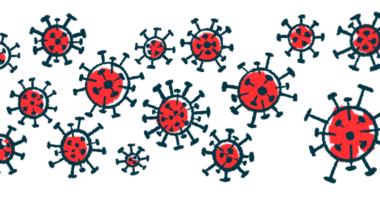Shorter Telomeres on Chromosomes, DNA Damage, May Contribute to SSc

Shorter telomeres — the protective ends on chromosomes and a marker of aging — were observed in people with systemic sclerosis (SSc), particularly among those with lung fibrosis (scarring) or anti-topoisomerase-I autoantibodies (ATA), according to a recent study.
In a mouse model of scleroderma, treatment with GSE4 — a peptide that prevents telomere shortening and DNA damage — reduced skin fibrosis. Moreover, GSE4 treatment in human cells reduced the expression of fibrosis-related proteins.
The results together suggest that telomere shortening and DNA damage may be involved in SSc-related fibrosis, and targeting these processes could be a promising therapeutic approach, according to the researchers.
The study, “Evidence of telomere attrition and a potential role for DNA damage in systemic sclerosis,” was published in Immunity and Ageing.
Telomeres form the ends of chromosomes, which carry genetic information. With natural aging, telomeres become progressively shorter, serving as a cellular marker of lifespan.
Telomere shortening also has been previously associated with diseases involving fibrosis, or scar tissue buildup, particularly those that affect the lungs.
While fibrosis of the skin and other organs is a hallmark feature of systemic sclerosis, the relationship between telomere length and SSc has not been well-established.
To shed light on the matter, a research team in Spain now examined telomere length in the blood of 174 SSc patients and 68 healthy volunteers.
Across both groups, telomere length progressively shortened with age.
Overall, people with SSc had shorter telomeres than healthy participants, with 40.8% of patients having severely decreased telomere length compared with 8.6% of controls.
Among the SSc group, shorter telomeres were observed particularly in patients with lung fibrosis. Furthermore, the presence of ATA antibodies — an indicator of scleroderma correlated with lung involvement — was associated with shorter telomere length.
No differences were observed between people with limited or diffuse forms of SSc.
Telomere length also was not associated with the duration of disease or severity of lung involvement, suggesting that telomere length “may be an early event and not a consequence of the progression of the disease,” the researchers wrote.
GSE4 is a peptide thought to induce the activity of telomerase — an enzyme that works to elongate telomeres — and prevent DNA damage, two processes that contribute to cell senescence, or damage caused by aging.
When the team administered GSE4 in a mouse model of scleroderma, they observed significant reductions in skin fibrosis and in the levels of fibrosis-related proteins, compared with mice not given GSE4.
Next, the researchers took samples of fibroblasts from SSc and healthy participants. Fibroblasts are the cells that become faulty in SSc and overproduce the structural protein collagen, leading to excess skin buildup and scar tissue. In cell cultures, the fibroblasts were treated with bleomycin or TGF-beta — two proteins that induce fibrosis — followed by GSE4.
In cells from both healthy controls and SSc patients, treatment with the fibrosis-promoting proteins increased gene expression of COL1A1, CTGF, and ACTA2, three connective tissue proteins involved in fibrosis. GSE4 treatment countered the effects of the pro-fibrotic therapy, reducing expression of these genes.
GSE4 also inhibited expression of the DNA-damaging protein pH2A.x in cells exposed to bleomycin.
Altogether, the results suggested that processes that contribute to cellular aging (senescence) may contribute to the development of fibrosis in SSc.
“These findings suggest that processes leading to fibroblast senescence such as telomere attrition or DNA damage may be relevant pathogenic factors in the development of fibrosis in SSc and support the therapeutic potential of telomere or DNA protective strategies,” the researchers concluded.
In related news, some scleroderma patients with lung disease and shorter telomeres were previously reported to have anti-telomere antibodies, which were suggested to be a potential new biomarker for SSC with lung involvement.







